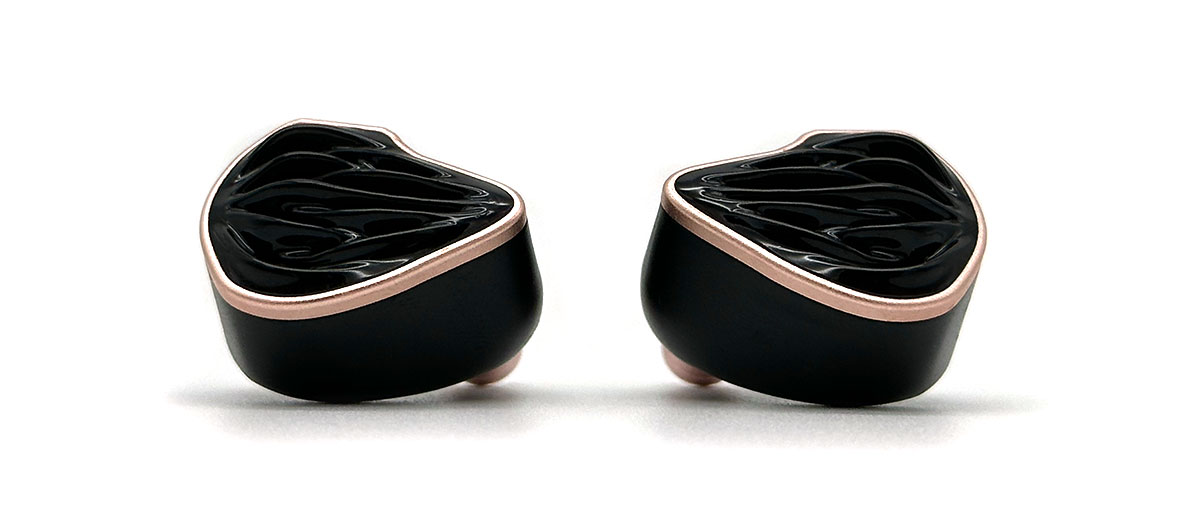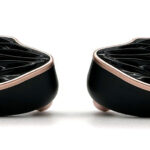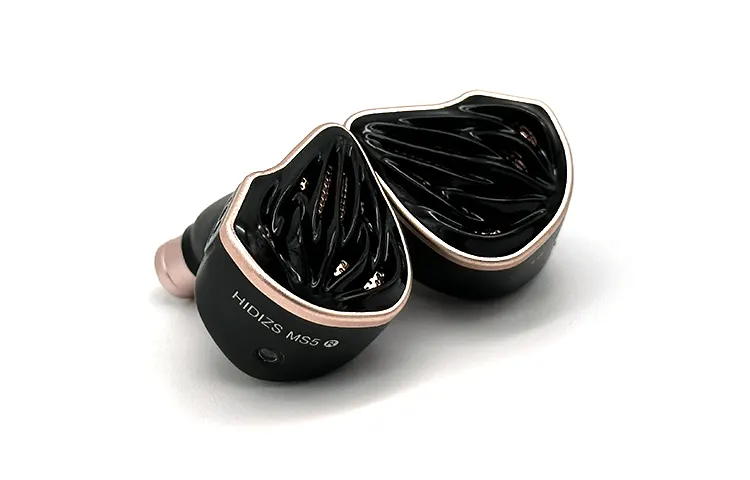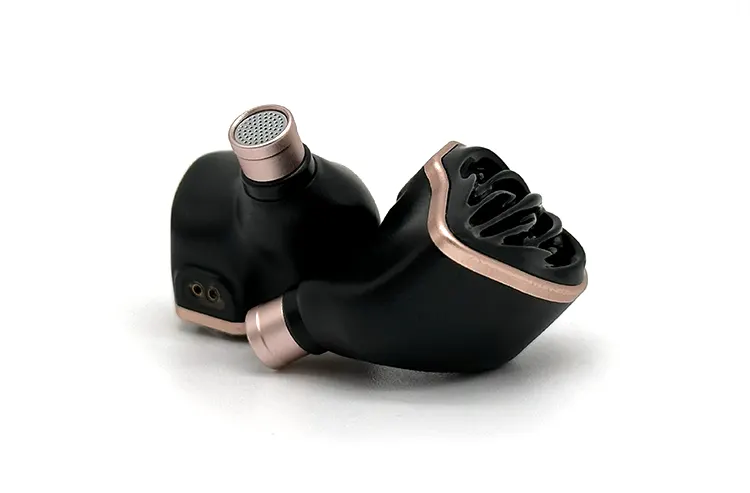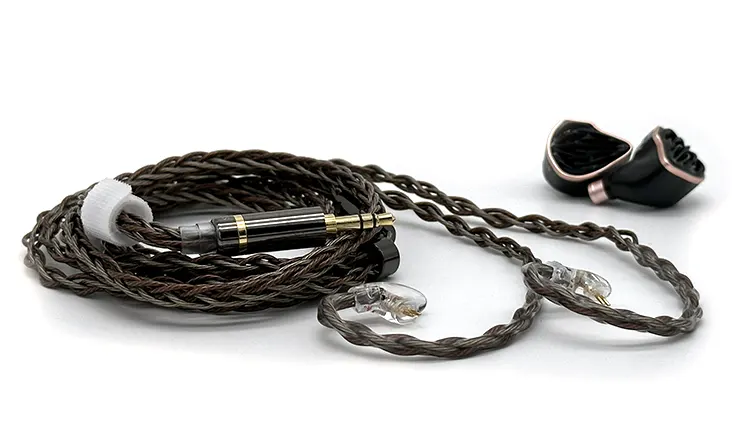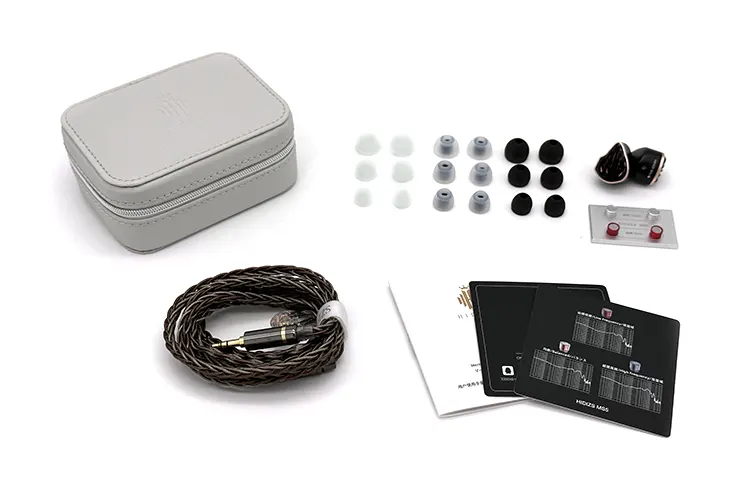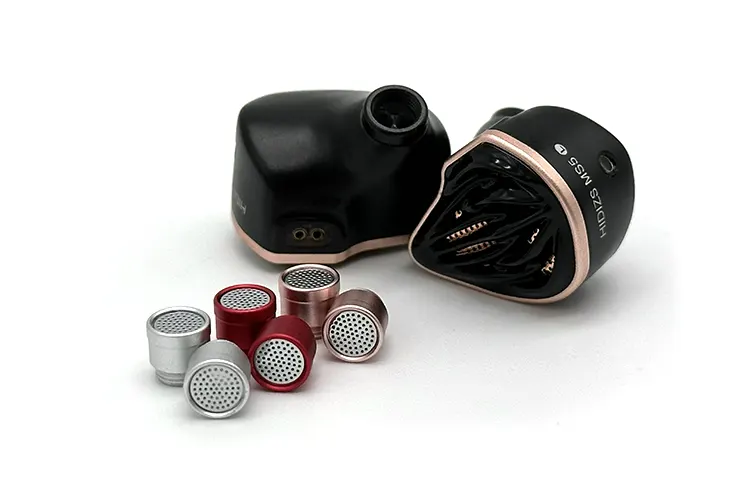Today, we review the Hidizs MS5, which is a new hybrid single dynamic and 4-balanced armature driver universal IEM with unique tuning filters. It is priced at $499.
Disclaimer: This sample was sent to us in exchange for our honest opinion. Headfonics is an independent website with no affiliate links or status. We thank Hidizs for this opportunity.
To read more about Hidizs products we have previously covered on Headfonics click here.
Note, that this article follows our current scoring guidelines which you can read up on here.
More than a couple of years have passed since the MS4 was released. Several bang-for-buck IEMs have been added to their inventory since then like the MM2 and the MD4 but it has maintained its TOTL spot for Hidizs’ portable monitors.
Now that the MS5 has arrived, the MS4 is finally passing the baton. Dubbed ‘dark angel’ by Hidizs themselves, there are several key highlights to the MS5 that are theoretically intended to fly high with performance.
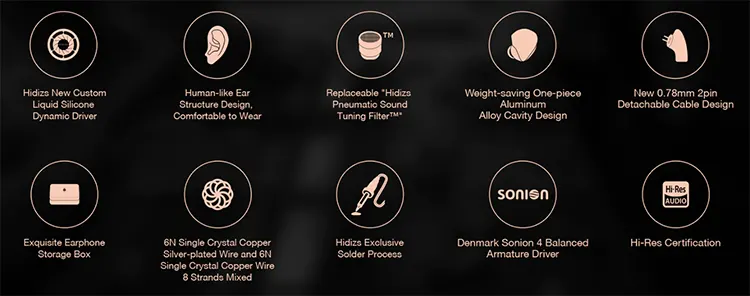
Tech Highlights
The Hidizs MS5 is a multi-driver hybrid universal IEM with a blend of four balanced armature drivers from Sonion together with an in-house designed custom-made dynamic driver.
With their pedigree, building a custom 10mm liquid silicone driver is not farfetched to Hidizs. What’s more surprising is they omitted Knowles BA in their latest creation which is the one they kept using before.
Listed on the company’s website are the exact part numbers for the balanced armatures used in the MS5. Among the three varieties mentioned, it is implied that there is at least one dedicated unit for each section of the frequency range.
As for the dynamic driver, it is designed from a sandwich injection molding process with a layer of liquid silicone around a thin Kevlar sheet. This creates a highly efficient driver where the MS5 is measured at just 5.3Ω impedance and 104dB SPL sensitivity @1kHz.
Heightening its significance to would-be owners is that one can also play with the tuning seeing the nozzles are screwed and not fixed. Called a Hidizs Pneumatic Sound Tuning Filter™, this triples the sound possibilities. Picky listeners would find this indispensable in finding the right balance for a particular genre or mood.
Design
The new ‘dark angel’ of Hidizs is joining the Mermaid series with a unique set of target audiences. And yet, might as well say that I find the MS5 to have a strong image of what it wants to be.
Almost the entire design is black with a matte black shell and a glossy black face plate. The reflective resin carved with the unusual ‘angel wings’ has grooves where a layer of rose gold mesh peeks through.
The intention of the wing pattern wasn’t obvious to me at first seeing the lines meet in a central vertical line. However, once I gave the MS5 a little bit of an angle, the face started to look like a bird’s wing.
Part of the distinctive design of the MS5 is the screw-on nozzles that can be removed to adjust the tuning. I can only observe that the thread is smooth which makes replacing filters quick and easy.
Comfort & Isolation
The Hidizs MS5 may not exactly be featherlight, but wearing it is not a chore either. The mixture of many elements used by Hidizs makes it possible to just listen and forget about the monitors even though they’re on the bigger side when fitted.
However, depending on the tips used, it can give a bit of discomfort when the unit gets moved caused by external movement. Good thing the housing has positive points of contact so it doesn’t get pushed inwards continually.
At least finding a good seal was easy. Any of the provided tips fit well, which is expected since there is minimal difference in the three silicone choices. Only the vocals being shorter than the rest had a tougher time staying secure.
The ear guides will likely protect the MS5 against any accidental fall. I like how aggressive the hooks are plus they’re also angled inwards in a way that they place the position of the IEM correctly instead of relying upon the seal of the tips to hold it in place.
Those looking for a well-isolating passive IEM will find the MS5 lacking. Obviously, in punching several vent holes in the face, putting the MS5 on will let in more noise than the average closed design. It still does well enough in this regard that a busy nearby street was substantially brought down to tolerable levels.
Tips
Unlike other IEMs that I’ve tried, I didn’t have to guess the tuning target of the tips Hidizs kindly included in the package. Because instead of simply differentiating by materials and colors, clearly written as well are the three choices of signature for balanced, vocals, and bass.
The balanced tuned tips are what I used for this review. Hidizs confirms that the fitted rose gold filters are set to their standard so I didn’t want to touch that by using the vocal and bass-focused tips.
The single flanged vocal and balanced tips slope gently downwards while the bass ones are more rounded in nature. The tips made for balanced sound have a harder stem while the other two are softer overall.
Made in all-white silicone, the vocal-tuned tips are the shortest and the ones with the widest bore diameter. On the flip side, the bass tips are in all black and are more or less equal to the height of the balanced tips.
Stock Cable
With the MS5, save for some minor microphonics when touched directly above the split, I consider the stock cable a great complement to the IEMs.
For now, there is no balanced option for the MS5. The one included in the box is using a 3.5mm jack on one end and a pair of removable 0.78mm 2 pins on the IEM side. With a brawny attribute to the braided 8-core cable, the terminations are duly adjusted to not feel scrawny in comparison.
Hidizs mentioned a couple of times that their new housing for the detachable 2-pin connectors is built with intention. It shows, and not just because the pins are see-through exposing the conjunction of wires inside, but because the mold is also crucially beneficial to the excellent fit of the MS5.
The cable is 1.2m long and divided into equal parts of pure 6N single-crystal copper wire and silver-plated ones. Hidizs has used some nice materials for the sleeve so it does not feel tacky to hold or too stiff.
Packaging & Accessories
The Hidizs MS5 arrived in a big and shadowy box with a shiny print of the IEM’s left earpiece in the middle and the familiar Hidizs crown logo on the upper corner. For the rest of the writings on the outer cover, all the specs from the basics to the more detailed ones are translated into English, Chinese, and Japanese.
The M5 drivers are housed in the top broad cardboard cutout top layer and not much else besides it save for a Hidizs logo in gold. It starts to get interesting further down below when almost all the accessories are laid neatly in plain sight.
Nine pairs of tips are provided and labeled to their tuning characteristics but only two out of three pairs of tuning filters can be seen since the third is already screwed into the MS5. Aside from the paper works hiding below the provided case, the last thing to discover is the single-ended removable cable zippered inside.
I’m liking the case even though it is not exactly pocketable. Aside from being easy on the eyes, the construction itself is also made with iron sheets for a mix of toughness and beauty.
Sound Impressions
The balanced filters were used in the formulation of the sound impressions. How the sound is changed by swapping the tuning filters will be discussed separately.
Summary
The Hidizs MS5 mesh of BA and dynamic driver pulls together nicely. Each blow is tweaked to an adequate surge of oomph adding plenty of room to focus on individual notes where required without sounding messy for everything else in the mix.
This charming attribute is sweet enough but not overly done. Mixed in with proper dynamic quality, the punch and body of the mid-bass are impactful. Whilst letting through important details, those looking for a solid delineation may find the softer dispersion of the MS5 lacking.
The MS5 is not harsh with vocals with decent weight and a natural tone that is far from sounding anemic or shrill. On the flip side of having a non-irritating tonality, vocal breaths get easily overtaken by more important parts.
The MS5 continues to bring life to instruments that are kind of dull without overstepping boundaries. The MS5 has a calmness that wouldn’t sound rushed in an acoustic song adding a friendly timbre to each string being strummed.
Chimes don’t get as much emphasis so plucks of strings that reverberate in the same direction overtake some ringing. Cymbals can sound a bit dry at times but overall, they have a pleasingly refined quality from the balanced armature configuration.
The treble though is not recessed since some electric guitars do elevate over the vocal region. It remains light not asking to be the main star but it could use more bite and dynamics for busy rock songs.
Staging
For a hybrid, the MS5 does have a cohesive sound and great directionality. The vented face probably aids in giving soundscapes a naturally floating placement which is a nice match to the signature it is going for.
The MS5 is not stretching the staging by any means. Vocals are given enough forward depth to not become claustrophobic but pulled closer by the scale of its notes that gets softly dispersed in a huge area.
The height of the overall picture is tall but concerts will not get overly wide. This plays to the advantage of the MS5 on other use cases doing well to use up the limited stage and not leave a gap in the center.
Since the low-end remains tight and doesn’t get too excited, it remains easy to isolate and pinpoint from a source. The MS5 does well to not let the bass encroach on neighboring notes.
Filters
Coming from the balanced set of filters, the swap to the treble-focused ones couldn’t be more obvious. I immediately noticed the tip into a more crystalline sound that exaggerates the highs a little bit for added expansiveness.
Electric guitars aren’t as held back and also less forgiving, which makes tackling busier parts easier. Chimes and guitars also play along more evenly than before. The treble filter works towards a crisper bite so cymbals are not as spineless.
Hidizs placed just enough lift to the upper midrange to not let it get swallowed by the now dominant treble region. The MS5 conveys subtler parts of a female voice reducing the amount of softness around the edges to prevent it from getting hushed.
Bright singers on the treble filter however cannot hide behind the natural timbre of the balanced filters. Letting the energy run free, the MS5 is more prone to sibilance.
Swapping to the bass filters enriches the thump of the MS5 with warmth. Well executed to not be bass canons, the MS5 now carries a more casual sound that cares less about the micro and more about the macro.
The bass filter doesn’t touch the tonal balance too much aside from a noticeable increase in presence around the lower vocal region where female voices receive added weight and forwardness. Treble instruments as well can be perceived as slightly heavier sounding.
Click on page 2 below for pairings and our selected comparisons




